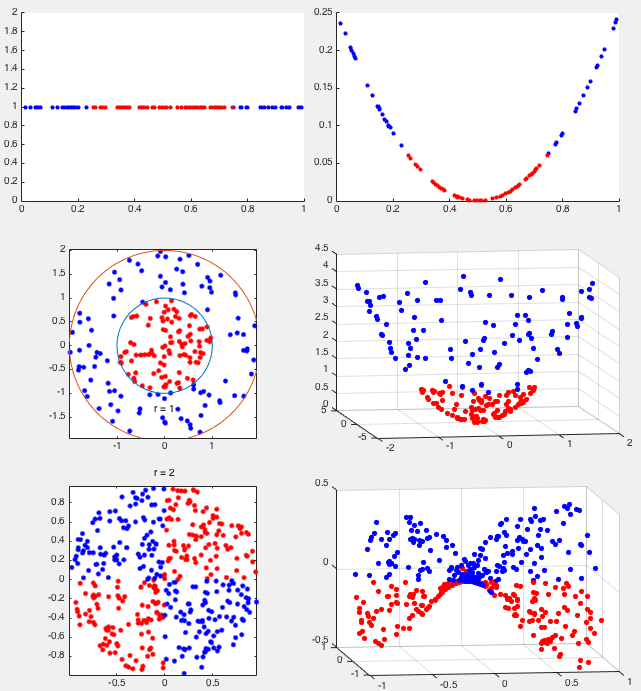Next: Soft Margin SVM Up: Support Vector machine Previous: Maximal Margin and Support
The SVM algorithm above converges only if the data points of the two classes in the training set are linearly separable. If this is not the case, we can consider the following kernel method.
In the kernel method, all data points as a vector
![${\bf x}=[x_1,\cdots,x_d]^T$](img3.svg)

 |
(94) |
 in the algorithm,
and the kernel function
in the algorithm,
and the kernel function
 never needs to be
actually carried out. In fact, the form of the kernel function
never needs to be
actually carried out. In fact, the form of the kernel function
 and the dimensionality of the higher dimensional
space do not need to be explicitly specified or known.
and the dimensionality of the higher dimensional
space do not need to be explicitly specified or known.
The motivation for such a kernel mapping is that the relevant operations such as classification and clustering may be carried out much more effectively once the dataset is mapped to the higher dimensional space. For example, classes not linearly separable in the original d-dimensional feature space may be trivially separable in a higher dimensional space, as illustrated by the following examples.
Example 1
In 1-D space, classes



![$\displaystyle {\bf z}=\phi(x)=\left[\begin{array}{l}z_1\\ z_2\end{array}\right]
=\left[ \begin{array}{c} x \\ (x-(a+b)/2)^2 \end{array}\right]$](img370.svg) |
(95) |

Example 2:
The method above can be generalized to higher dimensional spaces
such as mapping from 2-D to 3-D space. Consider two classes in a
2-D space that are not linearly separable:


![$\displaystyle {\bf z}=\phi({\bf x})=\left[\begin{array}{l}z_1\\ z_2\\ z_3\end{array}\right]
=\left[\begin{array}{c}x_1\\ x_2\\ x_1^2+x_2^2\end{array}\right]$](img373.svg) |
(96) |
Example 3:
In 2-D space, in the exclusive OR data set, the two classes of


![$\displaystyle {\bf z}=\phi({\bf x})=\left[\begin{array}{l}z_1\\ z_2\\ z_3\end{array}\right]
=\left[\begin{array}{c}x_1\\ x_2\\ x_1x_2\end{array}\right]$](img374.svg) |
(97) |
Definition: A kernel is a function that takes two vectors




 |
(98) |
The kernel function takes as input some two vectors 




The following is a set of commonly used kernel functions



Assume
![${\bf x}=[x_1,\cdots,x_d]^T$](img3.svg)
![${\bf x}'=[x'_1,\cdots,x'_d]^T$](img383.svg)
 |
(99) |
The binomial theorem states:
 |
(100) |
 |
(101) |
 items into two bins (
items into two bins ( in one
and
in one
and  in the other). This result can be generalized to the multinormial
case:
in the other). This result can be generalized to the multinormial
case:
 |
(102) |
 |
(103) |
 balls into
balls into  bins with
bins with
 balls in the ith bin (see here), and the
summation is over all possible ways to get
balls in the ith bin (see here), and the
summation is over all possible ways to get  non-negative integers
non-negative integers
 that add up to
that add up to  .
.
Now consider the homogeneous polynomial kernel for d-dimensional vectors
![${\bf x}=[x_1,\cdots,x_d]^T$](img3.svg)
 |
 |
 |
|
 |
 |
(104) |
![$\displaystyle {\bf z}=\phi({\bf x})=\left[\sqrt{ \frac{n!}{k_1!\cdots k_d!} }
\...
...1}\cdots x_d^{k_d}\right),\;\left(k_i\ge 0,\;\sum_{i=1}^d k_i=n\right)\right]^T$](img396.svg) |
(105) |
In particular, when 

![${\bf x}=[x_1,x_2]^T$](img399.svg)
 |
(106) |
![${\bf z}=\phi({\bf x})=[x_1^2,\,\sqrt{2}x_1x_2,\,x_2^2]$](img401.svg) is a mapping
from
is a mapping
from  in 2-D space to
in 2-D space to  in 3-D space.
in 3-D space.
A non-homogeneous polynomial kernel is defined as
 |
(107) |
The RBF kernel is defined as
 |
(108) |
 is a parameter that can be adjusted to fit
each specific dataset. This kernel can be wriiten as the inner product of
two infinite dimensional vectors (for simplicity, we assume
is a parameter that can be adjusted to fit
each specific dataset. This kernel can be wriiten as the inner product of
two infinite dimensional vectors (for simplicity, we assume  ):
):
 |
 |
 |
|
 |
![$\displaystyle e^{-\vert\vert{\bf x}\vert\vert^2/2} \; e^{-\vert\vert{\bf x}'\ve...
...!}{k_1!\cdots k_d! }
\left((x_1x'_1)^{k_1}\cdots (x_dx'_d)^{k_d}\right) \right]$](img409.svg) |
||
 |
 |
||
 |
 |
(109) |
![$\displaystyle {\bf z}=\phi({\bf x})=\left[ e^{-\vert\vert{\bf x}\vert\vert^2/2}...
...1!\cdots k_d!}},
\;\left(n=0,\cdots,\infty,\;\sum_{k=1}^nk_i=n\right) \right]^T$](img412.svg) |
(110) |
 we have
we have
 |
 |
 |
|
 |
 |
(111) |
![${\bf z}=\phi(x)=\left[ e^{-x^2/2}\,x^n/\sqrt{n!},
\;(n=0,\cdots,\infty)\right]^T$](img417.svg) is a kernel function that maps a 1-D space into an infinite dimensional
space.
is a kernel function that maps a 1-D space into an infinite dimensional
space.
The method of kernel mapping can be applied to the SVM algorithm
consider previously as all data points appear in the algorithm are
in the form of an inner product. Specifically, during the training
process, we replace the inner product


 in
Eq. (89) by
in
Eq. (89) by
 for the
classification of any unlabeled point
for the
classification of any unlabeled point
 :
Again, we note that the normal vector
:
Again, we note that the normal vector  in Eq. (86)
never needs to be explicitely calculated. As now both the training
and classification are carried out in some higher dimensional space
in Eq. (86)
never needs to be explicitely calculated. As now both the training
and classification are carried out in some higher dimensional space
 , in which the classes are more likely linearly
separable, the classification can be more effectively. More generally,
the kernel method can be applied to any algorithm, so long as the data
always appear in the form of an inner product.
, in which the classes are more likely linearly
separable, the classification can be more effectively. More generally,
the kernel method can be applied to any algorithm, so long as the data
always appear in the form of an inner product.